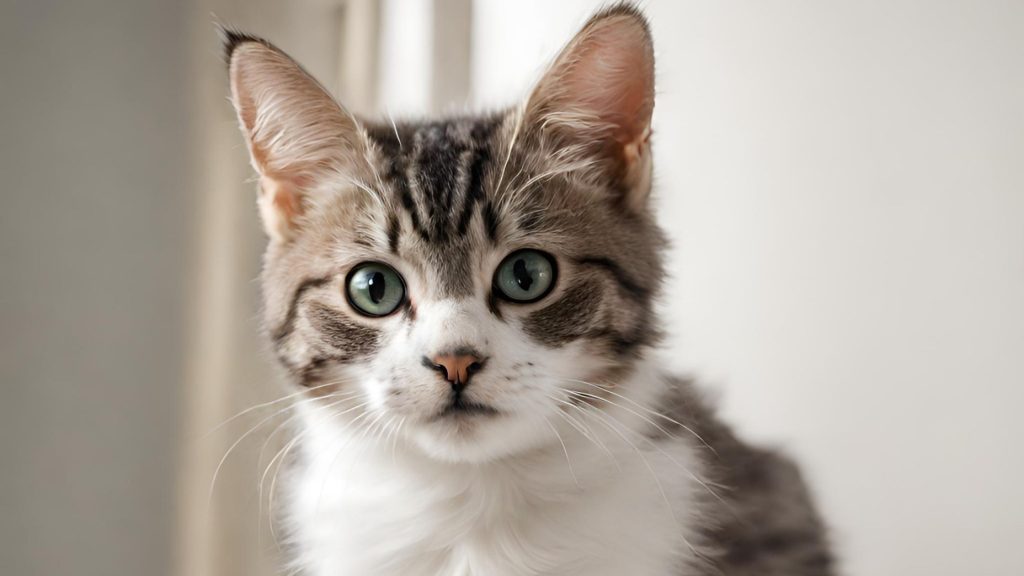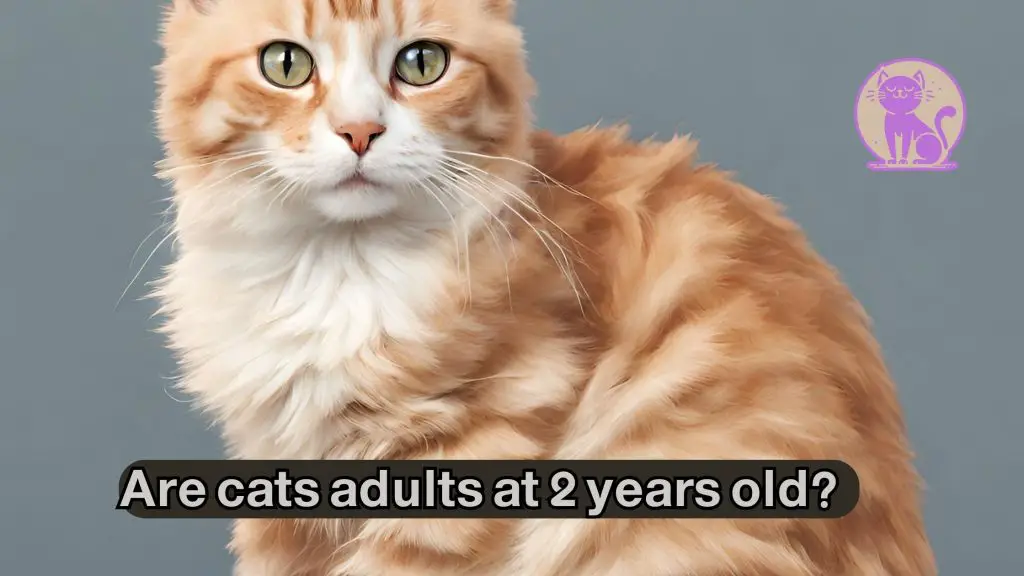For many cat owners, understanding cat adulthood is akin to solving a feline riddle. As your whiskered companion dashes through the house with endless energy, you might wonder: are cats adults at 2 years old? Timing in feline maturity isn’t just about blowing out two candles on a kitty birthday cake; it’s an essential part of ensuring your pet’s well-being. From playful kitten antics to the steadier pace of a grown cat, each phase in the cat’s developmental stages brings its joys and challenges. Join us as we unravel the mystery of when your furry friend is no longer a kitten and what adulthood truly means for our cherished felines.
Understanding Feline Maturity and Growth

When it comes to understanding the progression from frisky kitten to serene adult cat, it’s essential to consider various milestones and markers. A cat’s journey to maturity is multifaceted, flowing across a cat growth timeline that encompasses physical development, behavioral changes, and the inevitable comparison of cat age to human years.
Defining Cat Adulthood
Reaching adulthood in cats is more than a simple birthday celebration; it’s a complex series of developments that signal a shift in dependency, behavior, and physiology. While the exact point of transition can vary, most experts agree on a general feline maturity age to guide owners.
The Biological Markers of Feline Maturity
Like the onset of adolescence in humans, the shift towards feline adulthood comes with observable biological changes. These include physical indicators such as the completion of dental development and sexual maturity. Understanding these signs helps caretakers recognize when their pet requires the shift from kitten kibble to adult cat cuisine.
Comparing Feline and Human Age Equivalents
Assessing cat age in human years is not a straight 1:7 ratio, as many myths suggest. A more nuanced approach takes into account the accelerated maturity of cats in their initial years with a gradual slowing down as they reach middle age. This understanding is vital not just for trivia, but for aligning care with the cat’s life stage.
Feline Developmental Milestones
As your feline companion grows, understanding the critical stages of development is essential for providing the best kittens care. From day one as a newborn kitten to the point when are cats fully grown, their needs change significantly. Let’s delve into the key growth periods that define their early lives and set the stage for adulthood.
Newborn Kitten Phase
The journey of a feline begins with the newborn kitten stage, during which the caregiver’s role is pivotal. These fragile little creatures rely entirely on their mother—or a human caregiver—for warmth, food, and protection. A consistent feeding schedule, adequate warmth, and regular weight checks are among the paramount care aspects during this delicate time.
The Progression of Kittenhood
Kittens undergo rapid growth and development, with each week bringing new changes. They transition from solely nursing to starting on solid foods, from clumsy motions to graceful play. Socialization also plays a crucial role, as interactions with humans and other pets help shape their personality and behavior.
Transition to Adulthood
The passage from kittenhood to adulthood is a gradual but significant one. Cats are typically considered fully grown by one year, yet some larger breeds may continue to develop until they are two. It is during this time that their care needs adjust once again, pivoting towards maintaining a healthy weight, ensuring regular exercise, and fostering emotional well-being.
| Age | Developmental Milestones | Kittens Care Tips |
|---|---|---|
| 0-2 Weeks | Closed eyes, beginning to crawl | Keep warm, feed every 2 hours |
| 2-4 Weeks | Eyes open, start to explore | Introduce wet food, begin litter training |
| 4-8 Weeks | Weaning, increased playfulness | Socialize with humans and other pets |
| 2-6 Months | Rapid growth, learning boundaries | Continue socialization, regular vet check-ups |
| 6-12 Months | Reaching sexual maturity, full set of teeth | Spay/neuter, transition to adult cat food |
| 1-2 Years | When are cats fully grown for most breeds | Maintain a balanced diet, regular exercise |
Cat Age in Human Years: Debunking the Myths

The topic of cat age in human years has been a source of many myths and general confusion among pet owners. While some believe that one human year equates to seven cat years, this oversimplification can lead to misunderstandings about a cat’s life stage and healthcare needs. It’s crucial to debunk these myths and present a more accurate guideline for converting cat years to human years.
It is often said that the first two years of a cat’s life are equivalent to 24 human years. However, feline aging is much more rapid during their early years and then slows down considerably. The correct calculation of a cat’s age in human years can provide insight into their developmental stage and help owners cater to their pet’s individual needs more effectively.
| Cat Age | Equivalent Human Age |
|---|---|
| 1 Month | Approx. 6 Months |
| 3 Months | Approx. 4 Years |
| 6 Months | Approx. 10 Years |
| 1 Year | Approx. 15 Years |
| 2 Years | Approx. 24 Years |
| 5 Years | Approx. 36 Years |
| 10 Years | Approx. 56 Years |
| 15 Years | Approx. 76 Years |
| 20 Years | Approx. 96 Years |
Understanding the correct cat age in human years is more than a numerical game; it’s a significant factor in determining their diet, exercise, and health check-up routines. Vets and cat experts have derived more sophisticated models to assess a cat’s age in human years, taking into account their physical and developmental milestones.
- Kittens grow quickly and require high-energy diets.
- Adolescent cats, often ranging from 3 to 6 years, maintain high activity levels.
- Adult cats may need dietary adjustments as their metabolism starts to slow.
- For senior cats, monitoring health becomes increasingly important to maintain quality of life.
Accurately translating cat age into human years enriches the bond between felines and their human companions, aligning care with the subtleties of their aging process. Next time you celebrate your cat’s birthday, consider their ‘human’ age—it could provide a valuable opportunity to tailor their health check-ups and routines for the year ahead.
Cat Growth Timeline: From Kitten to Fully Grown

Understanding the cat growth timeline is pivotal for cat owners who yearn to comprehend the journey their feline companions undergo from playful kittens to dignified adult cats. Each stage of growth brings its unique developmental milestones, which collectively signal when cats are fully grown. The progression is not merely a physical transformation but also involves changes in behavior and needs.
| Age | Developmental Stage | Physical Milestones | Behavioral Milestones |
|---|---|---|---|
| 0-2 weeks | Newborn | Eyes and ears begin to open | Dependent on mother for warmth and milk |
| 3-8 weeks | Socialization Period | Growth slows down, and sexual maturity reached | Learning to socialize with siblings and humans |
| 2-6 months | Juvenile | Rapid growth, beginning of sexual maturity | Increased playfulness, exploration, and independence |
| 6-12 months | Adolescence | Growth slows down, sexual maturity reached | May exhibit territorial and mating behaviors |
| 1-2 years | Young Adult | Fully grown in size, physical maturity | Settling into adult behavior patterns |
| 3-6 years | Prime Adult | Physical peak, maintenance of adult weight | Stable and routine behavior, prime of health |
| 7-10 years | Mature Adult | May begin to show signs of aging | Less active, more time spent resting |
| 10+ years | Senior | Signs of aging more evident | Needs adjustment in diet and healthcare |
It’s important to note that these timelines are estimates, and individual cats may reach these milestones at different paces. Factors such as breed, genetics, and environment can influence when a cat is fully grown. Regardless, monitoring your cat’s progression through the cat growth timeline allows you to provide tailored care that supports their well-being at each stage of life.
Are Cats Adults at 2 Years Old?
When it comes to feline growth and maturity, age is not just a number. The lifecycle of a cat brings with it distinct developmental stages that ascertain maturity. While many pet parents consider the two-year mark as the official transition into adulthood, understanding cat adulthood requires a deeper insight into various aspects of a cat’s growth.
Physical Maturity of a 2-Year-Old Cat
At two years old, most cats have reached full size, a clear indicator of physical maturity. Their bones have fully developed, muscles are well-formed, and reproductive maturity has been established. However, just like humans, cats can continue to fill out and gain muscle even after they have stopped growing in height.
Behavioral Signs of Adult Cats
Behavioral changes also signify that kittens are transitioning to adult cats. A 2-year-old cat may display increased independence, territorial behaviors, and less playful aggression. Their sleeping patterns start to resemble the classic cat naps associated with adult cats, interspersed with periods of alertness and activity.
Considering Each Cat’s Unique Development
It is vital to acknowledge that each cat is an individual and may reach these milestones at different rates. Factors such as breed, environment, nutrition, and healthcare all play significant roles in how a cat develops. While the answer to “Are cats adults at 2 years old” is typically yes, cat owners need to tune into their pet’s specific needs and development cues.
| Developmental Milestone | Typical Age Range | Behaviors and Traits |
|---|---|---|
| Socialization Period | 2-7 weeks | Initial interactions with humans, other animals, and environments. |
| Juvenile Period | 7 weeks – 6 months | High energy play, continued growth, and learning boundaries. |
| Sexual Maturity | 6 months – 1 year | Onset of puberty and associated physical and behavioral changes. |
| Physical Maturity | 1 – 2 years | Reach full size, muscle development, and start showing adult behaviors. |
| Behavioral Maturity | 2+ years | Settled behaviors, routine daily cycles, territorial stability. |
In conclusion, the journey through cat developmental stages is complex, unfolding in both discernible milestones and subtle shifts. Understanding cat adulthood, especially around the age of two, empowers cat parents to support their feline friends during this critical time of maturation and throughout their lives.
Caring for Your Cat Through Their Developmental Stages

As cat owners, understanding the nuances of kitten care and the various cat developmental stages is vital to providing a nurturing environment for our feline companions. At each stage of their growth, cats have specific needs that require attentive care, ensuring they develop into healthy, well-adjusted adults. From the fuzzy days of kittenhood to the graceful leap into their twilight years, we’ll cover essential care tips tailored to each stage of your beloved pet’s life.
- Kittenhood (0-6 months): This stage demands frequent feedings, a warm and safe environment, and beginning litter box training. Regular check-ups and vaccinations are crucial during this time.
- Juvenile (6 months-1 year): Continue with routine vet visits and maintain a balanced diet. Introduce more complex toys and interactive play to support their physical and cognitive development.
- Young Adult (1-3 years): At this stage, monitoring their weight and providing structured playtime is key. Behavioral training to establish boundaries and prevent unwanted habits is also important.
- Mature Adult (3-7 years): Focus on maintaining a consistent routine with diet and exercise to avoid obesity. Keep an eye out for any changes in behavior, which could signal health issues.
- Senior (7+ years): Senior cats may require diets formulated for older felines. Provide easier access to resources as they may have less mobility and adjust their environment for comfort.
Keep in mind, these stages are general guidelines, and individual cats may progress uniquely. Always consult your veterinarian for advice tailored specifically to your cat’s health and needs.
Remember, the journey you share with your cat through each stage of life can be filled with joy and bonding. Cat developmental stages come with their own set of challenges, but with proper kittens care and attention, you and your feline friend can navigate them with ease and happiness.
Kittens Care: Essential Tips for Early Stages
As the guardians of our feline friends, it’s imperative that we support their graceful leap from a newborn kitten to graceful felines. The journey of kitten care requires dedication, and a robust understanding of the cat growth timeline is fundamental. It begins with attentive nurturing in their early stages to set the tone for a healthy and well-adjusted life.
Feeding and Nutrition for Growing Kittens
Proper nutrition during the early stages of a kitten’s life is vital for its development. Feeding your fluffy companion a balanced diet tailored to their growth requirements ensures they receive the necessary nutrients to thrive. Formulas specifically designed for kittens provide the right mix of proteins, fats, and vitamins to support their rapid growth rate and high energy levels.
| Age | Frequency | Type of Food | Important Nutrients |
|---|---|---|---|
| 0-4 weeks | Every 2-3 hours | Mother’s Milk or Kitten Formula | Protein, Amino Acids |
| 4-8 weeks | 3-4 times a day | Transition to wet food | Taurine, Vitamins, Water Content |
| 2-4 months | 3 times a day | Wet and Dry kitten food | Calcium, Phosphorus |
| 4-6 months | 2-3 times a day | High-quality kitten food | Fatty acids, DHA |
Health Check-ups and Vaccination Schedules
Maintaining a preemptive approach to health care through regular veterinary check-ups is crucial. Vaccination schedules begin early for kittens, safeguarding their growing immune systems from preventable diseases. Starting from six to eight weeks of age, kittens should embark on an initial vaccine series, followed by booster shots as advised.
- 6-8 weeks: Initial FVRCP (feline viral rhinotracheitis, calicivirus, and panleukopenia) and possible FeLV (feline leukemia virus) vaccinations
- 10-12 weeks: Second round of FVRCP and FeLV
- 14-16 weeks: Final round of FVRCP and rabies vaccine
- 1 year: Booster shots as recommended by veterinarian
Socializing Kittens to Prepare for Adult Life
Socialization is another cornerstone of kitten care. Introducing kittens to various stimuli including people, pets, and environments ensures they adapt well socially. An early start in socializing reduces fear and aggression in cats and paves the way for friendly adult behavior. It is a segue to a harmonious life ahead.
- Early handling by different people to promote friendliness
- Exposure to other vaccinated pets to assist in behavioral learning
- Introducing various environments to build confidence and adaptability
- Encouraging gentle play to teach self-control and boundaries
Cat Training Strategies: Basic to Advanced Techniques

Transforming your cat from a curious kitten into a well-mannered feline companion requires a blend of patience, love, and the correct training strategies. Whether you’re looking to lay the foundations with simple commands or delve into the potty proficiency of cat toilet training, we’ve compiled a wealth of tips to guide you through the process. Additionally, for those with older felines, we explore the intriguing question of their capacity for learning anew. Let’s begin the journey towards a harmonious household with your cat.
How to Train Your Cat with Positive Reinforcement
In the realm of cat training, positive reinforcement is not just effective; it’s essential. Cats respond wonderfully to treats and praise, which makes them ideal for promoting good behavior. Begin by identifying your cat’s preferred cat training treats; these will be your primary tool for encouraging and reinforcing the actions you desire. Consistency is key – ensure you reward behaviors immediately after they occur, creating a clear association in your cat’s mind.
- Start with basic commands like ‘sit’ or ‘stay’.
- Use a clicker to mark the desired behavior, followed by a treat.
- Keep training sessions short and sweet to maintain your cat’s attention.
Cat Toilet Training Essentials
Cat toilet training is a game-changer for cat owners, saving time and ensuring a clean home environment. Initiate this process with a simple litter box, and gradually move towards a toilet seat adapter if you desire. It’s important to make this transition gradually, ensuring your cat feels safe and secure at each step of the way.
- Place the litter box in a permanent, accessible location.
- Encourage your cat to use the litter box by placing them in it after meals and naps.
- Gradually introduce a toilet training kit, adjusting your cat to the new arrangement.
Advanced Training: Can You Teach an Old Cat New Tricks?
The adage “You can’t teach an old cat new tricks” is not entirely true. Older cats may have more set routines, but with the right approach, they can learn new behaviors. It may require extra patience and gentle encouragement, but how to train your cat at any age can be a fun and rewarding task for both of you.
| Training Aspect | Younger Cats | Older Cats |
|---|---|---|
| Adaptability to New Behaviors | High | Moderate to High (Varies by individual) |
| Training Techniques | Positive Reinforcement, Clicker Training, Frequency | Positive Reinforcement, Consistency, Patience |
| Attention Span | Short, Easily Distracted | Longer but Requires Engaging Tasks |
Understanding your cat’s preferences and temperament is the foundation of training at any stage of their life. Keep in mind that older cats may require softer training treats or alternative motivators such as affection or a favorite toy.
“Feed the Cats” Training Program: A Guide to Good Nutrition and Behavior
Introducing the innovative Feed the Cats Training Program, a nuanced approach that unites the vital elements of nutrition and behavioral training to nurture a harmonious and healthy lifestyle for your feline friends. This expertly designed program is grounded on the concept that proper feeding goes hand-in-hand with effective training, each influencing the other to promote overall well-being and domestic harmony.
At the core of the Feed the Cats Training Program is the belief that cats are not just pets; they are family members who deserve the finest care. We delve deep into understanding the unique nutritional needs of your cat at every stage of their development, pairing these findings with positive behavioral training strategies that ensure they grow up healthy in body and mind.
“Good nutrition creates health in all areas of existence. All parts are interconnected.” – This statement perfectly encapsulates the philosophy of our program.
While the idea of training your cat might seem daunting, this program caters to an array of personalities and learning curves – factors that both cats and owners will appreciate. Much like the importance of a nutritious diet, the training aspect is infused with patience, understanding, and the celebration of small victories along the journey of learning.
- Comprehensive diet plans tailored to your cat’s age, breed, and health status
- Behavioral conditioning techniques to foster obedience and mitigate common feline behavior issues
- Progress tracking tools to witness the tangible results of a well-nourished and well-trained cat
To effectively put the Feed the Cats Training Program into practice, a systematic approach is recommended, which brings about not only a well-fed cat but one that exudes confidence and tranquility. This program also provides insights into how certain foods can affect behavior, offering a dual-purpose solution to both diet and demeanor.
Whether you’re looking to streamline your cat’s feeding schedule or integrate training exercises that promote mental stimulation, the Feed the Cats Training Program provides you with the roadmap to success, ensuring all bases are covered for a happy, healthy pet.
Understanding the Cat Aging Process: Recognizing Signs of Maturity
As our feline companions grow, understanding the cat aging process is essential for providing the best care. Observing the key physical and behavioral changes can help us recognize when cats are fully grown and transitioning into maturity. This section examines these transformative years, guiding cat owners through the nuances of cat adulthood.
Physical Changes in Maturing Cats
The journey from playful kitten to serene senior is marked by several notable physical shifts. A full-grown cat, which is generally reached at about two years of age, will display a more settled physique and a well-developed musculature. However, the maturing process doesn’t halt there. As cats age beyond this point, they may begin to show signs such as greying fur, particularly around the muzzle, and a possible decrease in activity levels.
How Behavior Alters with Age
Behavior is another aspect of the cat aging process that shifts significantly. Understanding cat adulthood involves noting changes like reduced agility during play and a more sedentary lifestyle. Intelligence and experience shape their responses to the environment, leading mature cats to be less impulsive and more discerning in their actions.
Adaptations to a Senior Cat’s Lifestyle
As cats enter their senior years, it’s crucial to adapt their environment and care routine to their evolving needs. This can involve adjustments such as softer bedding to support aging joints, more accessible litter boxes, and regular veterinary check-ups to monitor health. Senior cats may also benefit from diets tailored to their reduced energy levels and specific nutritional requirements.
| Age Range | Physical Changes | Behavioral Changes | Lifestyle Adaptations |
|---|---|---|---|
| 2-3 Years | Development of full adult musculature | Increasing confidence and territorial behavior | Regular play to maintain health |
| 4-6 Years | Stable weight, peak physical condition | Settling into established routines and behaviors | Optimal diet for maintaining ideal body condition |
| 7-10 Years | Beginning signs of aging, such as greying fur | Less tolerance for disruption, preference for calm | Introduction of senior-specific diets and health checks |
| 11+ Years | Possible age-related conditions like arthritis | Reduced interest in high-energy activities | Enhanced comfort measures and modified environment |
By staying attuned to the evolving needs of our aging cats, we can ensure that their golden years are comfortable, healthy, and joyful. Whether you’re adjusting their daily routine or modifying their physical environment, understanding the cat aging process enriches the bond you share with your feline friend throughout every stage of their life.
Conclusion: Embracing Your Cat’s Journey to Adulthood
As we’ve explored the intricate web of feline development, we’ve learned that understanding cat adulthood is not just about ticking off milestones, but about appreciating the nuanced progression of life that our furry companions experience. From the early innocent days of kittenhood to the confident strides of maturity, each phase of a cat’s life is a testament to their adaptability and growth. Delving into the world of cat developmental stages has revealed that whether at the playful age of six months or the more sedate years that follow, our cats are continuously evolving, both physically and behaviorally.
The journey to adulthood in cats is a multifaceted saga marked by a series of transformative milestones. Far more complex than merely reaching the two-year mark, becoming a grown cat encompasses a spectrum of biological and behavioral changes that merit close observation and appreciation. Acknowledging these transformations can enhance our bonds with our cats and enable us to provide them with care that’s calibrated to each unique stage of their development.
By immersing ourselves in the journey our cats undertake as they progress from playful kittens to dignified adults, we’ve equipped ourselves with the knowledge to foster their growth in a nurturing way. Staying attuned to their evolving needs at every juncture ensures that we can offer the companionship and care they deserve through all seasons of life. Therein lies the joy of pet stewardship – witnessing and contributing to the unfolding narrative of our beloved cats’ lives as they step confidently into the realm of adulthood.
FAQ
Q: Are cats adults at 2 years old?
A: While cats have reached their full size by 2 years old, “adulthood” is a term that can include various stages of a cat’s life. Behaviorally and physically, many cats are considered adults by this age, but they may still show playful, kitten-like behavior.
Q: What are the biological markers of feline maturity?
A: Biological markers of feline maturity include reaching sexual maturity, which occurs between 6 to 9 months for most cats, the development of adult teeth by 6 months old, and the cessation of growth, which typically happens by 12 to 18 months.
Q: How do feline and human age equivalents compare?
A: The first two years of a cat’s life correspond to about the first 25 human years, with each successive year being approximately four human years. However, this comparison can vary based on breed and individual health factors.
Q: When are cats fully grown?
A: Most cats are fully grown by about 12 to 18 months, but some larger breeds can take up to 2 years or longer to reach their full size. This doesn’t always indicate full maturity, as development can still be underway.
Q: What are the developmental milestones for a kitten?
A: Developmental milestones for kittens include their eyes opening at about a week old, beginning to walk at 2-3 weeks, weaning off mother’s milk around 8 weeks, developing adult teeth by 6 months, and reaching sexual maturity shortly after.
Q: What is the cat growth timeline from kitten to fully grown?
A: The cat growth timeline starts with the kitten phase (0-6 months), where rapid growth occurs. Adolescence is between 6-18 months, during which they reach full size and sexual maturity. The adult phase follows, with senior years beginning around age 7.
Q: How can you tell if a 2-year-old cat has reached physical maturity?
A: A 2-year-old cat that has reached physical maturity usually has a full set of adult teeth, a robust and filled-out body, and has stopped growing. Female cats may have gone through heat cycles, and males may exhibit marking behaviors.
Q: What behavioral signs indicate a cat is an adult?
A: Adult cats often have more predictable and calm behavior than kittens. They may have established routines, show territorial behaviors, and have less intense bursts of energy, although individual personalities widely vary.
Q: How can you care for your cat through their developmental stages?
A: Caring for your cat through developmental stages involves proper nutrition suited to each life stage, regular veterinary checkups, vaccinations, age-appropriate play, and activity to support their growth and behavioral development.
Q: What are essential early-stage kitten care tips?
A: Essential early-stage kitten care tips include ensuring they are kept warm, feeding them a high-quality kitten formula (or mother’s milk), helping them eliminate waste if they are very young, and beginning socialization and handling to prepare them for adult life.
Q: What are the basics of how to train your cat with positive reinforcement?
A: Training your cat with positive reinforcement involves rewarding good behavior with treats, praise, or playtime to encourage the behavior to be repeated. It’s important to be patient, consistent, and to use short training sessions.
Q: What are the essentials of cat toilet training?
A: Cat toilet training essentials include maintaining a clean litter box in a quiet, accessible location, showing kittens where it is, and encouraging its use after meals and naps. Some cats can even be trained to use human toilets with special kits and patient training.
Q: Can you elaborate on the “Feed the Cats” training program and its benefits?
A: The “Feed the Cats” training program focuses on combining good nutrition with behavioral training. It usually includes scheduled feeding times that coincide with training sessions, helping to establish routine, satisfy nutritional needs, and reinforce good behavior.
Q: What physical changes indicate a cat is maturing?
A: Physical changes in a maturing cat include reaching full body size, the development of adult teeth, thickening of the coat, and sometimes a more pronounced musculature in males. Older cats may start to show signs of aging such as a graying muzzle and weight changes.
Q: How does a cat’s behavior alter with age?
A: As cats age, they often become less active and playful, may sleep more, and their routines can become more ingrained. Older cats might also become more vocal or demanding and may develop some cognitive changes similar to senility in humans.
Q: How should you adapt to a senior cat’s lifestyle changes?
A: To adapt to a senior cat’s lifestyle changes, ensure they have easy access to food, water, and comfortable sleeping areas without needing to jump or climb. Regular veterinary check-ups to manage age-related health issues are also essential, as is adjusting their diet to suit their lower energy needs.








